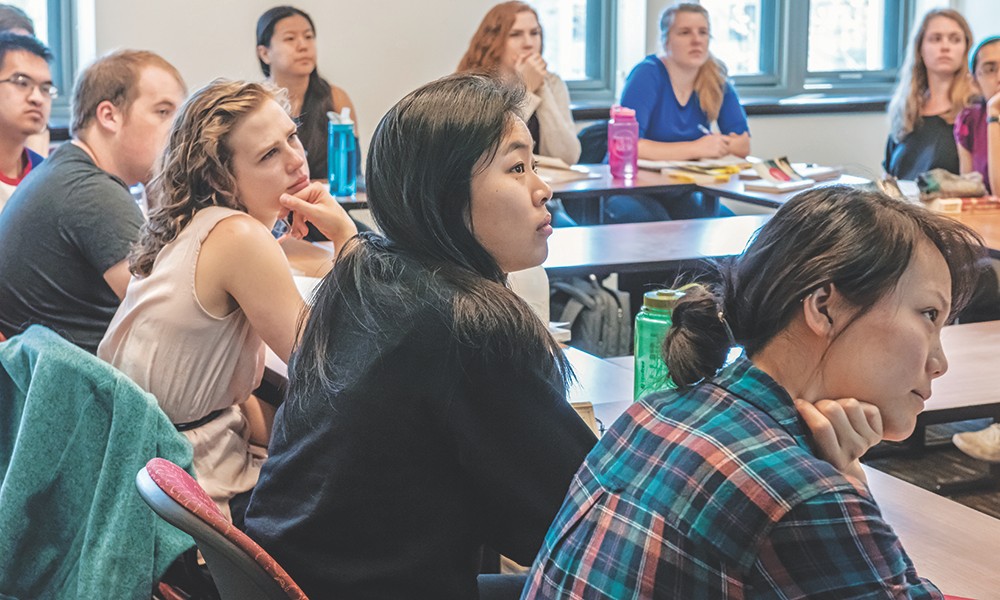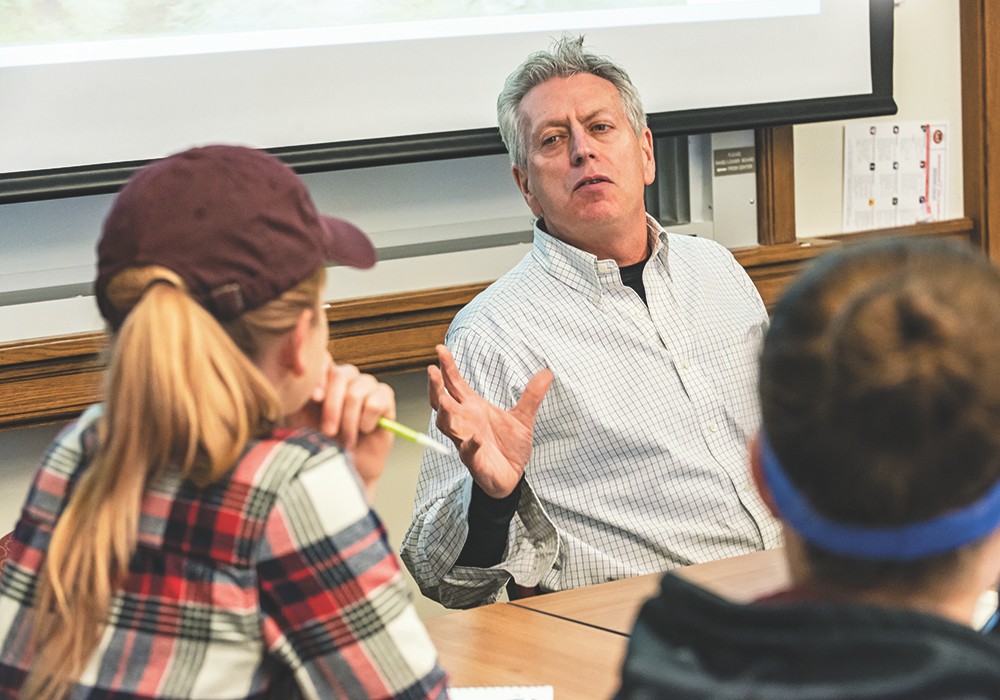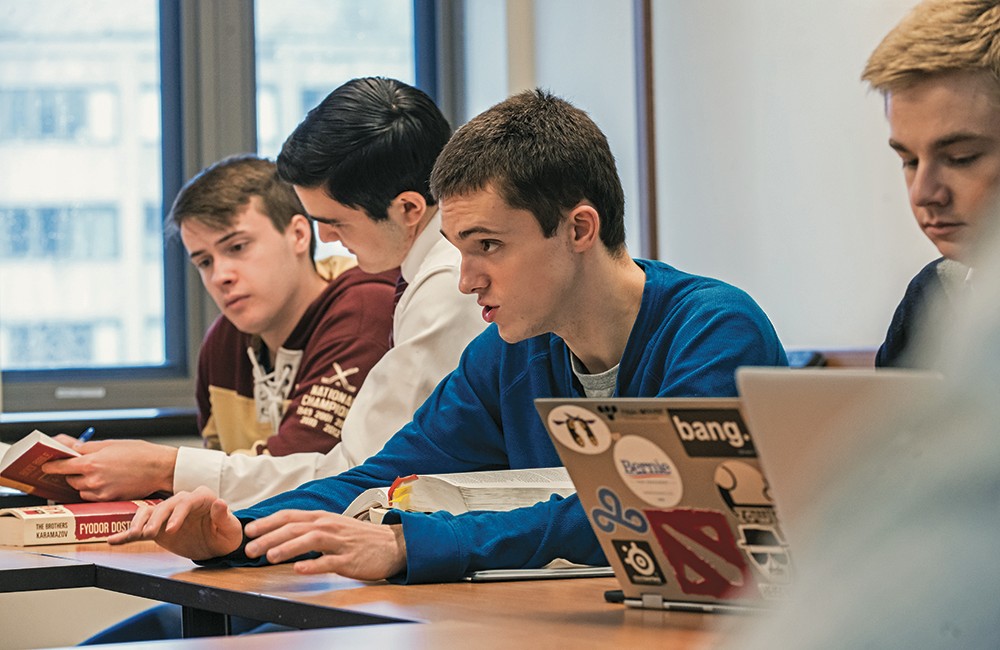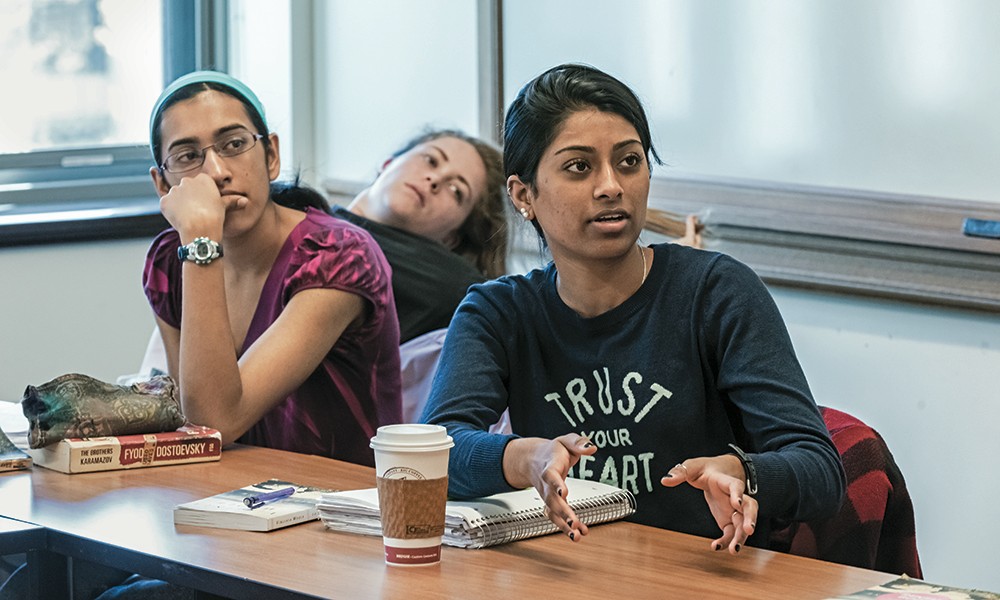Photographs by Lee Pellegrini for Boston College Magazine.
"Frazer literally read himself blind, gang, isn’t that fantastic?” said Mark O’Connor, leaning over the seminar table, resting his weight on the tips of his fingers.
It was late April, in Stokes 205S, two weeks before O’Connor completed his 43rd and final year of teaching at Boston College, and his 37th consecutive year of teaching “Western Cultural Tradition V–VIII,” a required two-semester seminar for sophomores in the four-year Arts and Sciences Honors Program. O’Connor’s course focuses on European cultural movements from the Renaissance to existentialism, and on some three-dozen assigned readings in literature, philosophy, theology, and psychology, in addition to dozens of paintings and musical compositions examined in class. It runs from The Prince (1532) and Shakespeare’s Richard II (1595) through To the Lighthouse (1927).
Dressed, as he generally is, in faded blue jeans and a white Oxford, a nest of keys hanging from his belt loop, a shock of graying hair swooped upward, a tattered, dog-eared paperback book and a stack of handwritten instructional notes on the table before him, O’Connor was for the last time teaching The Golden Bough, the anthropologist Sir James George Frazer’s 1890 (though he didn’t complete a final version until 1915) study of religion and mythology. O’Connor was treating it the same way he treats each of the seminar’s texts, with fervor and as a challenge to his students: “Frazer brilliantly argues that Christianity has no legitimacy and is no different than any other religion. Fight me if you disagree!”

The morning seminar, during a discussion of Manet’s White Lilacs in a Crystal Vase.
On that day, the seminar’s 14 students were considering Frazer’s account of the cult of Attis, god of vegetation in Phrygia (now Turkey) circa 900 B.C. The son of a virgin mother (“Wowza, ring any bells?” chimed O’Connor, who has a penchant for antique exhortations), Attis bled to death under a tree (“crucifix, anyone?”), and was honored in a springtime festival (“hmm, Easter?”), at which priests, “stirred by wild, barbaric music,” as Frazer writes, castrated themselves.
While the class debated potential connections between Attis and Christianity, O’Connor began playing “wild, barbaric” music on the compact classroom’s sound system. It was Carlos Santana’s Woodstock performance of “Soul Sacrifice”—cymbals, cowbells, maracas, bongos, and Santana’s screaming guitar. He occasionally used background music in the seminar, O’Connor told me, so students “better comprehend, channel, and live the text.”
“Can you feel that?” O’Connor asked, his eyes closed, his head leaned back. Sitting in a tight horseshoe facing him, a few students tapped their feet, a few laughed, the rest scribbled notes. “Can you begin to understand, Gwyneth, a building spiritual fervor, Tommy, where you just might do something you later regret, Rosie?” O’Connor frequently stitches students’ names into a single sentence, to keep all on alert. As he told me, “If you ever dare yawn, you’re going to hear from me.”
I sat in on the two-hour seminar on Tuesdays and Thursdays from early March to May 4, when he taught his last class. Because most sections of the honors seminar for freshmen begin with The Odyssey, O’Connor concludes the sophomore class with Virginia Woolf’s “odyssey of a woman trying to make art and life meet, which is one of the aims of the seminar,” he says. The sophomore seminar, one of three courses that he’s been teaching since joining the Arts and Sciences Honors Program in 1977, surveys the “complexity and scope of Western intellectual accomplishment,” following, among other threads, the relationship between the individual and society, scientific inquiry, the beautiful, and the sublime.
Colleagues and former students affectionately and accurately call O’Connor a throwback. His teaching style calls to mind that of Robin Williams as a 1950s English teacher in Dead Poets Society (1989)—a blend of charisma, unyielding enthusiasm, animated readings in French, German, and Russian in addition to English, and a habit of striding across the room to stand behind a student and exclaim, “Does everyone see the brilliance of what X just said?”
Former student Jonathan Mulrooney ’91, now an associate professor of English at the College of the Holy Cross, says he tries to emulate what he calls O’Connor’s “sympathetic interruption.” When a student talks, O’Connor will often talk as well—echoing, responding, refining. “With most teachers this would make the student back off,” but with O’Connor’s encouraging tone and hand gestures, the student is “enlivened, and keeps going,” says Mulrooney. “In the end what results is a conversation of the teacher’s initial design but of the student’s own making.”
During one 20-minute stretch, I noted O’Connor make references to and draw links among Bach, Batman, Baudelaire, Bergman, Conrad, Dante, Darwin, Foucault, Freud, Homer, Homer Simpson, Job, Manet, Mozart, Nietzsche, Shakespeare (he recited Sonnet 98 from memory), Star Trek, Where’s Waldo?, O’Connor’s wife, son, and grandmother, and essays by former students. He does this, he says, to prod students to draw associations of their own: “What bothers me are students who compartmentalize too much, who only want to know what’s on the test.” O’Connor draws connections rapid-fire to “get students to test themselves, and think about the ways in which the seminar is a part of the much larger issue of intellectuality, how and what they will read throughout their lives."
During each year’s first class, O’Connor tells his students, "Our seminar only succeeds if we accept it as an act of collective salvation. It won’t work if you don’t care about who’s to your left and your right."
Mary Joe Hughes, who taught in the Honors Program from 1979 until retiring in 2013, told me of her colleague: “He knows the name of every student before the first class and probably something about his or her background. He’s interested in all students as whole people. He is open about his own faith and demonstrates by example that faith is compatible with intellectual sophistication. His is a teacher-centered classroom but one that justifiably feels like an ongoing family . . . of deep commitment, nurture, and care.”

O'Connor addresses Gwyneth Miner during the afternoon seminar on April 4.
Former student Patricia Noonan ’07, a New York City–based actor, singer, and playwright, said O’Connor was “the rare teacher who could give students a baseline of deep respect and confidence and yet push them hard at the same time.” O’Connor also “emphasized the need to question absolutes—to learn from flashes of insight.”
R. Nicholas Burns ’78, H’12, one of O’Connor’s first students, later became U.S. Under Secretary of State and ambassador to NATO. Now a professor at Harvard’s Kennedy School of Government, Burns said, “No other professor at BC or Harvard had a more protean approach or more infectious love of history than Mark.”
“I can still hear Mark reading one of [Siegfried] Sassoon’s [antiwar] poems, in the last year of the Vietnam War,” he added. “I had grown up with the notion that war could be heroic. [This was] a revelation for me. Mark was an extraordinary teacher because he asked us to pose ethical questions in history: Was this right? Was it ethical and moral?”
"There’s an old Roman proverb: Always leave the table while you’re still hungry,” O’Connor told me one day this spring, sitting in his tidy office in Stokes. He whispered for dramatic effect: “I’m still very hungry.” He wants to spend more time with his six grandchildren, however, and help take care of his 95-year-old father-in-law, and travel with his wife, Mary, a retired school teacher—”My much better half, my Mary, my Marysia,” is how he refers to her in class.
Framed class pictures from seminars going back more than a decade hang on his office walls, gifts from his students. He pointed from his desk chair to more than a dozen faces—recalling what she said about Freud and what he wrote about Cervantes. “My students made me better than I really am,” he said. In one photograph, students had Photoshopped themselves supine and outstretched aboard The Raft of the Medusa, Théodore Géricault’s early-19th-century rendering of shipwreck victims, an oil painting O’Connor uses to teach French Romanticism, and to explore “the idea that we are always caught between salvation and damnation.”
O’Connor says he’ll most miss “the smile—those moments you look across the table and you see a student get it. It’s a smile of understanding, it most represents our humanity, and it best represents the academic enterprise.”
Founding the Honors Program in 1958, Boston College joined more than 100 universities that launched similar ventures in postwar America as a means to attract stronger students nationwide. At the urging of University President Michael P. Walsh, SJ, English professor P. Albert Duhamel and academic vice president William Casey, SJ, proposed a curriculum for students “blessed by heredity or early training with more talents than the average.” When the Carnegie Corporation granted $85,000 to launch the program, $5,000 more than the University asked for, it noted a “concern that Catholic education has not made a large enough contribution to the preparation of scientists, research men, and college teachers.”
One of Boston College’s core curriculum options, the honors seminars start out as 12-credit, year-long courses. The freshman course begins with the Greeks, goes through the Hebrew Bible, and ends with Dante and Chaucer; the sophomore course ranges through Milton and Cervantes, Kant and Rousseau, and into the early 20th century. The junior seminar (six credits, one year) covers modernism and postmodernism. Seniors may write a thesis or take a seminar that revisits a text from earlier in the program.

From left: Liam Formisano, Thomas Toghramadjian, Matthew Eckstein, and Martin Gilgenast.
Today the Honors Program makes entry offers to incoming freshmen based on standardized test scores, application essays, teacher recommendations, and high-school class standing. Some 80 from an incoming class of 2,300 will enroll this fall. Several current and former students I talked with recalled that O’Connor remembered exact turns of phrase from their admission essays when he pitched the program to them on Admitted Eagle Day, which the University hosts each spring. O’Connor, who directed the Honors Program from 1997 to 2012, describes the four-year curriculum as a “survey of great books, great ideas, and great works of art, from a discernment approach. What constitutes greatness? Honors students will get a solid grasp of the history of debate over the timeless questions: Why am I here? How do I know when I’ve done something just, or wrong? Is art above nature or is nature above art?”
The South Shore native studied history at Holy Cross and earned his Ph.D. in Slavic studies from Boston College in 1978, writing his thesis on “Cultures in Conflict; A Case Study in Russian–Polish Relations: The University at Wilno.” He had been a lecturer in survey courses such as “Cultural and Intellectual History of Modern Europe from 1500 to 1789” and “The European Experience” when he received an invitation to teach a section of the sophomore honors seminar, then called “Modern Man,” in 1977.
The first year was a “disaster.” Of his eight students, says O’Connor, “two were geniuses, four were solid, and two weren’t even ready for college.”
John Howard, SJ ’59, MA’62, a longtime professor in the Honors Program, gave him some advice. “The most important books you’ll encounter are your students,” O’Connor remembers Howard telling him. “Each of them is just as involved, complicated, and multi-toned as anything Dostoyevsky wrote.” From then on, O’Connor would return to his office after each class and write notes on his students’ insights and questions, and then work them into the next seminar. “I learned to become six times over-prepared. Good students ask tough questions, and you don’t want to constantly be professing your ignorance,” he said. After spending a year in Poland on a research grant, he joined the Honors Program full-time in 1981.
He found himself learning more about teaching in the seminar than he did in a lecture course, “where you’re in complete control.” He prefers the seminar’s “intellectual ping-pong and unpredictability.” Still, he often lectured to start a class, to “calibrate” discussion. I watched him introduce The Brothers Karamazov with 15 minutes of Dostoyevsky’s biography, an etymology of the four brothers’ names, the novel’s roots in Scripture, and the historical context of the Revolutions of 1848 (“the revolutions that,” O’Connor said, pausing, and the class responded, “don’t revolve,” a familiar O’Connor phrasing).
He learned patience in his first years, he said. “I used to rush to explain. Eventually I gained the confidence to let every class get it on their own time, which gives them the confidence to propel the seminar forward.”

From left: Ciara Bauwens, Kiran Khosla, and Simi Siddalingaiah, during the final morning seminar.
During each year’s first class, O’Connor tells his students, “Our seminar only succeeds if we accept it as an act of collective salvation. It won’t work if you don’t care about who’s to your left and your right.” By that he means: Don’t score points over one another. Rather, try to feed off what the last seminar speaker said. Challenge one another to arrive at a more comprehensive understanding. At least half a dozen times I heard O’Connor respond to a student’s insight with something like, “Superb. Now, gang, let’s pick apart everything X just said.”
O’Connor has taught the Honors Program’s sophomore, junior, and senior seminars multiple times, but the sophomore seminar is his favorite. This year, his last at Boston College, he taught two sections. “I get to teach my favorite books,” among them The Brothers Karamazov, Heart of Darkness, and Frankenstein, he said. And sophomores, “at that point well-attuned to the program’s etiquette of attentiveness, always teach me something new about them.”
In addition to in-class discussion, on Thursday evenings “around repast time,” as he wrote in the syllabus, O’Connor emailed each class a weekly “intellectual dessert.” These were essay prompts that “extend beyond exegesis and consider the implications of why what we’re reading is worth a grown man or woman’s time.” Assignments from O’Connor’s final year included:
January 26
In 1759 Samuel Johnson’s Rasselas appeared almost simultaneously with Voltaire’s Candide. Johnson allegedly said that had they ‘not been published so closely one after the other that there was not time for imitation, it would have been in vain to deny that the scheme of that which came latest was taken from the other.’
Do you agree? Is it possible that two thinkers who so strongly clashed on fundamental issues such as the worth of Christianity nevertheless could have much in common? Johnson, after all, reviled the philosophes in general and Voltaire in particular, labeling him a ‘scurrilous dog.’
Please compare and contrast Candide and Rasselas as ‘philosophical tales,’ then try empirically to come to terms with what constitutes the Age of the Enlightenment by searching for common intellectual presuppositions uniting Voltaire and Johnson. In dealing with this larger problem, Kant’s essay ‘What is Enlightenment?’ should be used as a point of reference. David’s brooding Brutusdone later in the same decade as Kant’s essay may, perhaps, provoke some darker-still brooding.
April 20
Here’s the premise for your consideration: that Conrad’s Heart of Darkness is what the Germans call a ‘Kulturträger,’ that is, a culture-bearing work. Indeed we might want to term it a ‘golden bough’ that can bring us back, if we can bear the journey, to a bare, unadorned vision of our past. Or we might instead want to see in this heart the darkness produced by fecundity, a ‘tangled blank’ of a bough weighed down by all we have read, seen, experienced.
How might we now return to where we ‘began,’ ‘and know the place for the first time’? How might we understand earlier writings, paintings, and music we’ve explored in the ‘light’ Conrad’s novella sheds on what we’ve seen?
Over the years, the sophomore honors course under O’Connor added an emphasis on “the evolution of Western thought across media,” including landscape painting, classical music, and criticism. “I encourage dilettantism because I’m a dilettante myself,” O’Connor said. He took his students to museums and Symphony Hall concerts. He had them compare Voltaire’s Philosophical Dictionary (1764) with Mozart’s Don Giovanni (1787) and J.M.W. Turner’s The Slave Ship (1840), which offer “competing theories about the relationship between the good and beautiful,” he said. They contrasted Darwin’s On the Origin of Species (1859) with Courbet’s The Stone Breakers (1849), a rendition of peasants, one old and one young, in ragged clothing, breaking stones with a hammer—”works in conversation with each other about the evolution and aspirations of humanity,” he said. O’Connor “made every book, painting, and song we studied feel part of one conversation, and that we could join that conversation,” one current student told me. Emiley Zalesky Lockhart ’99, general counsel and policy director for the Massachusetts State Senate, told me that the seminar “loosened up the way I saw the world.” Lockhart added that O’Connor “showed you that the answers aren’t just in the text or in the painting or the music, they’re in how you weave them together.”
Nearly every time I asked O’Connor about his teaching philosophy, he cited two lines from the 16th-century French essayist Michel de Montaigne, whose work the seminar studies during the fall semester. Montaigne, says O’Connor, “is the ultimate wise guy, he’s beautifully engaging, and, crucially, he shows students that the life of the mind and the life they’re going to live can be a seamless garment.” As regards teaching, O’Connor cites Montaigne’s essay “Of Books”: “The only learning I look for is that which teaches me to know myself, and teaches me how to die well and to live well.” And O’Connor then references Montaigne’s final and, some contend, greatest essay, “On Experience”: “To compose our character is our duty, not to compose books, and to win, not battles and provinces, but order and tranquility in our conduct. Our great and glorious masterpiece is to live appropriately.”
“Montaigne composed his life by writing books. I’ve tried to compose my life by teaching the books that show how to compose a life,” O’Connor said.

Tina LaRitz '19, during the morning seminar.
On May 4, his last day as a teacher, during his morning seminar, O’Connor displayed on the screen a still-life bouquet of white lilacs in a crystal vase. “Manet painted this as he died,” O’Connor began. When Manet was dying of syphilis, his sister-in-law visited him each morning with flowers, which he painted. The lilacs in the painting reflect sunlight, and appear to be moving. “I find beauty here, I find life here,” said O’Connor. “Manet is making art out of nature, nature out of life. This is a great last testament worth striving for.” Normally, O’Connor sat facing the class and with his back to the painting he was elucidating. Now he stood looking at the painting, silent.
The seminar ended with Virginia Woolf’s To the Lighthouse, a novel centered on Mrs. Ramsay’s struggle to transcend her roles as hostess, housewife, and mother. The discussion had begun the previous weekend, when the two classes and a handful of former students caravanned to O’Connor’s retirement home in Charlestown, Rhode Island, along piping plover–filled Block Island Sound, a setting similar to the Ramsays’ summer home on the Isle of Skye. O’Connor hosted the penultimate session at his house for more than 25 years, “to extend the conversation beyond the classroom and urge them to continue the conversation into their futures.”
Now, in the classroom, they gave most of the final hour over to a four-page, stream-of-conscious scene in which Mrs. Ramsay retreats to her bedroom and knits, away from her many houseguests, her eight children, and her husband, a man “lean as a knife, narrow as the blade of one.” Students took turns reading paragraphs aloud. O’Connor called on two women to read the final paragraph in unison. Halfway through the first sentence, they broke into laughter at the strangeness of reading together. When they continued, they read with solemnity, as the world opened to Mrs. Ramsay: “There were all the places she had not seen; the Indian plains; she felt herself pushing aside the thick leather curtain of a church in Rome.”
One student said, “Woolf is arguing that no matter the limits of her situation, anything is possible in thought.”
“Anything is possible in thought,” O’Connor repeated. “This is what I mean when I say you are the lighthouses. You are the hope to the extent that you believe that to think hard, to think well, to think through is the most natural thing in the world. You must do this for yourselves first. Then you’ve got to share what you’ve learned.”
As O’Connor packed his book, laptop, and collection of notes from previous years’ seminars in his backpack, Emily Zhao ’19 stood up and said, “Professor O’Connor, thank you for teaching us that salvation is collective.” Then she presented him with a hardcover edition of The Brothers Karamazov, with 14 inscriptions.
An hour later, O’Connor began his afternoon seminar, and his two final hours of teaching. In celebration of his tenure, the Honors Program had invited faculty and many of O’Connor’s former students. Some 50 attended in the cavernous Murray Room. Sean Flahaven ’95, a producer of Broadway musical albums (including the Grammy award-winning Hamilton), and Sam Sawyer, SJ ’00, an editor at the Jesuit magazine America, had taken a train from New York City. Andrew Skaras ’15 had flown from Dallas, and reread To the Lighthouse on the flight. Four students from the morning seminar had come back for round two.
For the first 45 minutes, O’Connor and his current students, seated before him in a tight semi-circle at the front of the room, discussed a painting. Then O’Connor invited everyone in the room to join the seminar, to gather in a large circle.
For an hour, the group discussed Mrs. Ramsay’s musings. While students and younger alumni made references to Shakespeare, Darwin, and Scripture, the older alumni drew on their lives. James Miller ’90, CEO of an online gaming company: “Isn’t what happens between the Ramsays what happens in any relationship? The closer you get to someone, you realize the gap between you and fully knowing someone is much further than you imagined.” Flahaven: “Ramsay is just misperceiving his wife’s default expression. Having been in many long-term relationships, I know it’s a lesson one learns.”
Moments before class ended, Emiley Zalesky Lockhart challenged one of O’Connor’s long-held interpretations. Where O’Connor sees “profoundly abiding romance” in Mrs. Ramsay finally leaving the room where she’d been knitting and meditating to join her husband for a walk outside, Lockhart saw “submission,” a sacrifice of freedom in aid of keeping a frail marriage from shattering.
“What’s the last line of the book?” O’Connor said. “‘I’ve had my vision.’ Thanks to you, Emiley, I have a new vision of this.”
A reception followed. When the students had left, colleagues and former students came forward to offer toasts, to thank him for friendship, for letters recommending them for Fulbrights and law school and seminary. For his “boundless hope for all of us.”




